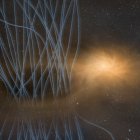The James Webb Space Telescope has just captured the most detailed images yet of the waving ‘mane’ of the Horsehead Nebulaa dense, distant cloud of gaseous particles that serves as a nursery for new stars.
“These observations show the top of the ‘horse’s mane’ or edge of this iconic nebula,” a NASA spokesperson said in an official press release, “capturing the complexity of the region with unprecedented spatial resolution.”
James Webb photographs the Horsehead Nebula in unprecedented detailGetty Images/iStockphoto
The sharpest infrared images
These observations, made by an international team of astronomers, reveal the complexity of this cosmic object with unprecedented spatial resolution and show a part of the nebula in the light of the infrared eyes of the Webb.
This nebula is located approximately 1,300 light years away from Earth, in the constellation of Orion (The Hunter). The Horsehead Nebula is also known as Barnard 33and formed from turbulent waves of dust and gas on the western side of the Orion B molecular cloud.

It was recorded for the first time in 1888 by the British-born American astronomer Williamina Fleming at the Harvard University Observatory. The astronomer, who was an assistant at the observatory, identified this intriguing structure in a photographic plate taken through the telescope. The nebula is part of a much larger complex in Orion, which includes the Orion Nebula (M42), one of the brightest nebulae visible to the naked eye.
New images from JWST, the most powerful telescope ever placed in orbit around our planet, show the nebula as turbulent waves of gas rising from the western side of the planet. Orion Molecular Cloud Complex, and measures approximately 3.5 light years across. It is considered one of the best objects in the sky for studying how radiation interacts with interstellar matter.
New images of the nebulaNASA, ESA, CSA, K. Misselt (University of Arizona) and A. Abergel (IAS/University Paris-Saclay, CNRS)
To take the impressive images, astronomers used the near-infrared camera (NIRCam) and the mid-infrared instrument (MIRI) by James Webb, which capture photons emitted in the infrared light spectrum as massive young stars heat regions of the gas cloud; something that helps scientists understand the chemical and physical processes that allow interstellar matter to evolve and stars to form.
One of the new infrared images from the James Webb telescope captures, in sharp color division, the region where a gas of cold hydrogen molecules (blue) transforms into energized “ionized” hydrogen atoms (red).
Another image shows mid-infrared light in great detail, as this heat was emitted by dusty quartz-like silicate particles and hydrocarbon molecules that form the deep space clouds in the Horsehead Nebula’s mane.
Detail viewNASA, ESA, CSA, K. Misselt (University of Arizona) and A. Abergel (IAS/University Paris-Saclay, CNRS)
“As ultraviolet light evaporates the dust cloud, dust particles are dragged out of the cloud and transported along with the heated gas,” NASA said in the James Webb study published in the journal Astronomy & Astrophysics. “Webb has detected a network of fine features that track this motion. The observations have also allowed astronomers to investigate how dust blocks and emits light, and better understand the multidimensional shape of the nebula.”
In the future, astronomers intend to study the spectroscopic data that have been obtained from the nebula to demonstrate the evolution of the physical and chemical properties of the material observed throughout the nebula. These images show that JWST is ready to make an impact on this research.
The final destiny of this nebula is its disappearance, although astronomers estimate that the Horsehead Nebula has about five million years before it disintegrates. The horse-shaped structure that makes this nebula so distinctive was created because lighter gas was eroded away, leaving a thick plume of dense gas and dust that is harder to erode. But this postcard won’t last forever. Webb’s new view focuses on the illuminated edge of the top of the nebula’s distinctive structure of dust and gas, providing a glimpse into its finite future.
ComparisonESA/Euclid/Euclid Consortium/NASA, image processing by J.-C. Cuillandre (CEA Paris-Saclay), G. Anselmi, NASA, ESA, and the Hubble Heritage Team (AURA/STScI), ESA/Webb, CSA, K. Misselt (University of Arizona), M. Zamani (ESA/Webb)
The $10 billion James Webb Telescope was built to observe the first galaxies born in the early universe. more than 13.5 billion years ago, to observe the sources of stars, exoplanets and even the moons and planets of our own solar system. It is the largest and most powerful orbital space telescope in the world. The infrared gaze of the Webb telescope will continue, as before, to illuminate the mysteries of the universe, allowing us to appreciate the wonders that surround us and deepening our understanding of the vast setting in which our planet finds itself.
References:
- Webb Captures Top of Iconic Horsehead Nebula in Unprecedented Detail. NASA Press Release 2024. NASA Webb Mission Team NASA, Goddard Space Flight Center. ESA, CSA, K. Misselt (University of Arizona) and A. Abergel (IAS/University Paris-Saclay, CNRS)






